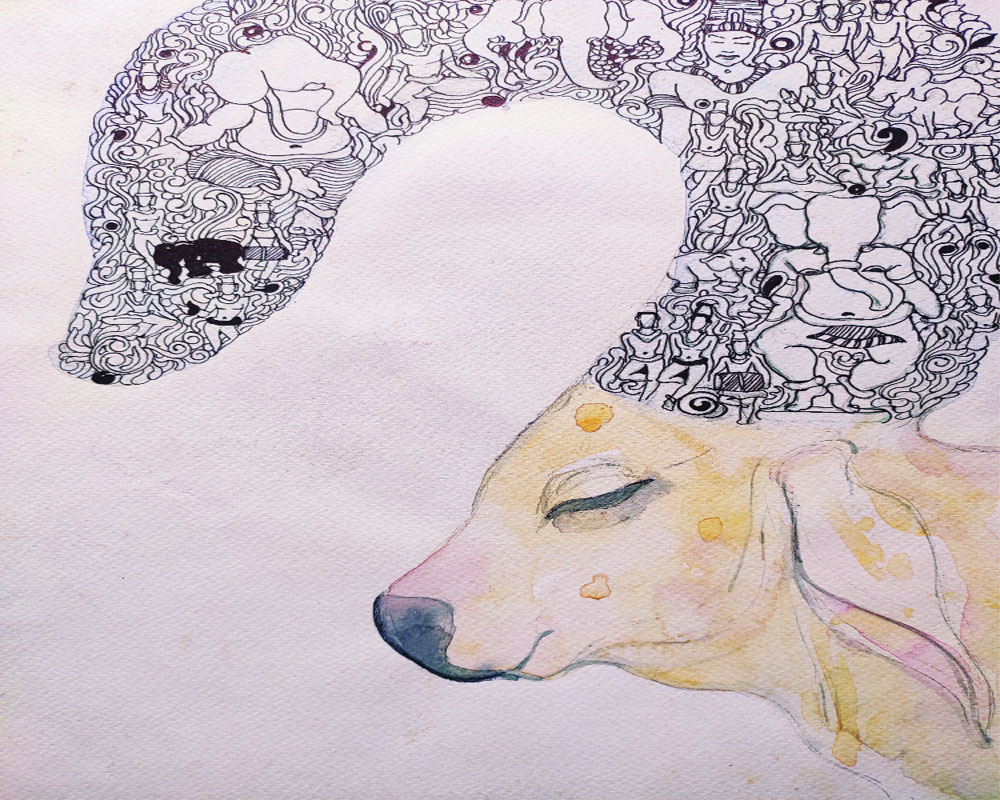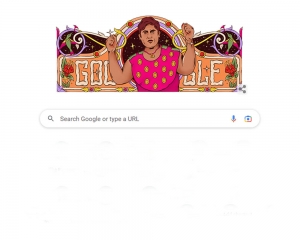Artist Santosh Chikanna’s works find their inspiration in the holy cow and the beauty of mythology. By Uma Nair
Lockdown unravelled the brilliance of artist Santosh Chikanna who lives in Bidar, Karnataka. It was his Holy Cow series that caught my gaze. It is an amazing composition, where the detailing of the divine appears to be his forte. He calls his series with an exclamatory dialogue; when you look at it, you can see the majesty of the miniature world, the beauty of mythology, his perennial fascination for the gods and some tales from the Puranas.
Bhakti and emotive essence
While his cow is both contemporary and traditional, it is his focus on the horn that radiates an energy that is at once evocative. Santosh recreates Lord Ganesha in different ways, striking up a conversation about the worship of gods and questioning as to how to look after the cow.
He says, “In Delhi, there are many who leave their cows back at home and wander, hoping to get some food. I have a cow that comes and bellows at my gate every morning at 6:30, and I feed her. Her trust in me is uncanny. Her eyes reflect a divinity I have rarely seen. There is the beauty of history and tradition and lifestyle and satire in these compositions as well as a sense of play.
The drawing on the horns evokes feelings of bhakti, or spiritual devotion, love for nature as well as worship and longing for the divine moment, but when used as storytelling, they mirror the same emotion in the viewer. The concept of bhakti goes back to ancient times and the Rig Veda. It is derived from the root ‘Bhai,’ which means to serve or adore. Bhakti cut across all sections of society and became accessible to one and all.
Maharashtra is full of stories of the bhakti movement and women saints. Scholars like J Stor say that in a sense, women did far better in the bhakti milieu but only within the metaphor of what was known as the pati-vrata dharma. There are some exceptions to this general description in the lives of women saints belonging to the Varkari tradition of Maharashtra. Some of them like Muktabai and Janabai even hold their own status in a male-dominated society. The conclusion drawn is that bhakti, though in a small way, paved the path for equality amongst the sexes, particularly in the medieval period. And Chikanna’s intricate imagery points towards this movement of growth.
Detailed designs
Looking at Chikanna’s cow images, we at once think of Nandi — Lord Shiva’s sacred bull. Nandi is Shiva’s faithful mount and the most devout worshipper — an embodiment of devotion. The young bull is popularly, but incorrectly, known as Nandi, “the joyful,” but is better referred to simply as Vrishabha, the “white bull.” He is understood as an expression of Shiva’s supreme wisdom and thus is also worshipped as a theriomorphic form of Shiva himself. Nandi always assumed an independent cult status. Shrines to Shiva’s bull are the testifies to the resilience of such cults. Chikanna’s imagery on the horns brings in the magic of folk art and echoes of the medieval era.
Miniature tradition
The exquisitely-detailed drawings tell us that Chikanna has studied the rigorous techniques of the miniature tradition — from gilding and hand-crafting the thickly-plied to carefully burnished paper supporting the careful application of colour with tiny pen, ink strokes, and curls and curves.
Chikanna has a velvet hand. He continues to experiment within the well-defined strictures of this traditional discipline. In both these examples, it is the finely-detailed portraits of the god set in sumptuously-filled landscapes, and replete with the meticulous detail that remind us of yesteryear imagery found in folios commissioned by the Mughal emperors. For Chikanna, there is an exquisite tension between the stringent parameters of this ancient practice and the modernity of his experience — one that speaks, in part, to the frictions of a world in which novelty and orthodoxy collide.
Expression becomes his leitmotif in his recreating the cow’s face. In a world ruled by paradoxes of glittering wealth and abject poverty and sometimes oppressive religion and debauchery, these two drawings present a masterful debut steeped in atmosphere and shimmering with the mystery of the human hand that can create works, which we can admire till eternity.


























